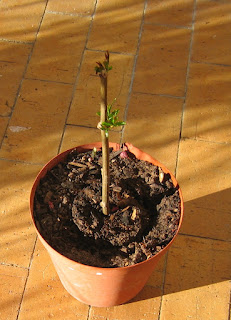Our grandson came to visit us for the Easter holidays - how lekker (nice is the normal translation, but obviously you all know that I mean much more than nice :-) ) that was. Very special! All he wanted to do was swim - but late March / early April in Cape Town is not really swimming weather - and the water has already cooled down quite substantially, although he did get in twice - very briefly - the water was 21oC. Much to cold for me!

BUT, whilst he was here I took delivery of my Stack-A-Tub - the name says it all. I have placed it on our back patio - the only place which gets sun in winter, and, co-incidentally, it is right outside our grandsons' bedroom window - so when he's here he can peep out of his window to see how "his" vegetables are growing. We planted baby spinach and a (centre) garlic clove in the top section and peas in the middle section - aiming for them to grow down the tubs as opposed to needing support. Trial and error - if they don't do that well hanging down then I'll give them support to climb up. My other half loves peas in the pod, which I can't find anywhere in Cape Town, so, providing we get enough from the nine plants, I know who I'll call if I need some shelled for dinner. In lower section I planted some basil, but I think I'm going to replace them with lettuces - basil will grow perfectly in a stand alone pot. The beauty of the stack a tub is that as all three tiers are detachable, it's obviously mobile, so when we go to the farm I can take it with us. I'm thinking of using it as a herb garden on the farm - close to the kitchen door.
I have also ordered some very special lemon tree cuttings from overseas. But I'm not going to say anymore until I have some fruit photo's to share with you - sorry, that'll take two or three years. But I'm very excited and can't wait for them to arrive. If they arrive alive, and I manage to root them successfully, then I will be ordering more. I can't see why I shouldn't be successful as I have managed to root two pomegranate cuttings in the past four weeks.
We are still unable to get away to the farm - perhaps later this month... We need to install the newly painted security gates, and, of course, my freecycle kitchen counters. But we have a neighbour who is also building his house there and he tells us that our plants / trees are all doing well with our irrigation system, and we've had a bit of rain, so we don't have to worry about them.
Would be nice to get away to the peace and serenity again though...


can you grow pomegranate from seed? my brother just gave us a pile of pomegranates and we love them! the best dessert is plain yoghurt, pomegranate and some yoghurt. amazing and healthy ;-)
ReplyDeleteSprig - welcome :-)
ReplyDeletePomegranate seeds can be harvested from the center of the pomegranate fruit, dried on a paper towel and then planted in moist potting soil.
Like tomatoes, let the seeds dry (of their outer fleshy sheath) for several days before planting them.
Plant the pomegranate seeds in potting soil-about 1 cm under the soil, and leaving about 4 cms between seeds.
Place the pots in a warm sunny area and water liberally until the soil is fully moist but not soaking wet. Wait for the pomegranate seeds to germinate and sprout - if they're viable, this should take roughly 2 weeks.
When the seedlings reach 10cms thin out the smallest Pomegranate seedlings by clipping them off the shortest sprouts at ground level. Again, this height should be reached in another 2 weeks after germination.
Let the pomegranate plants grow in a sheltered warm area until they reach at least 60cms high. Most healthy plants should reach 60cms within 2 months of germination.
Pomegranate plants need warm temperatures and lots of sunlight to flourish.